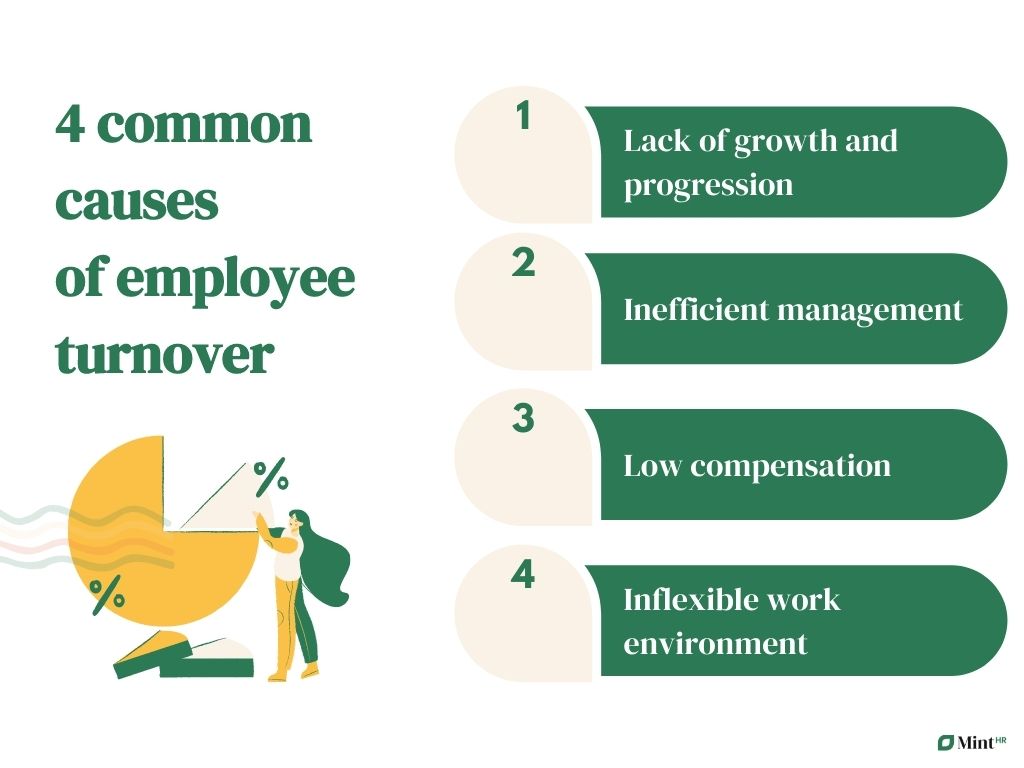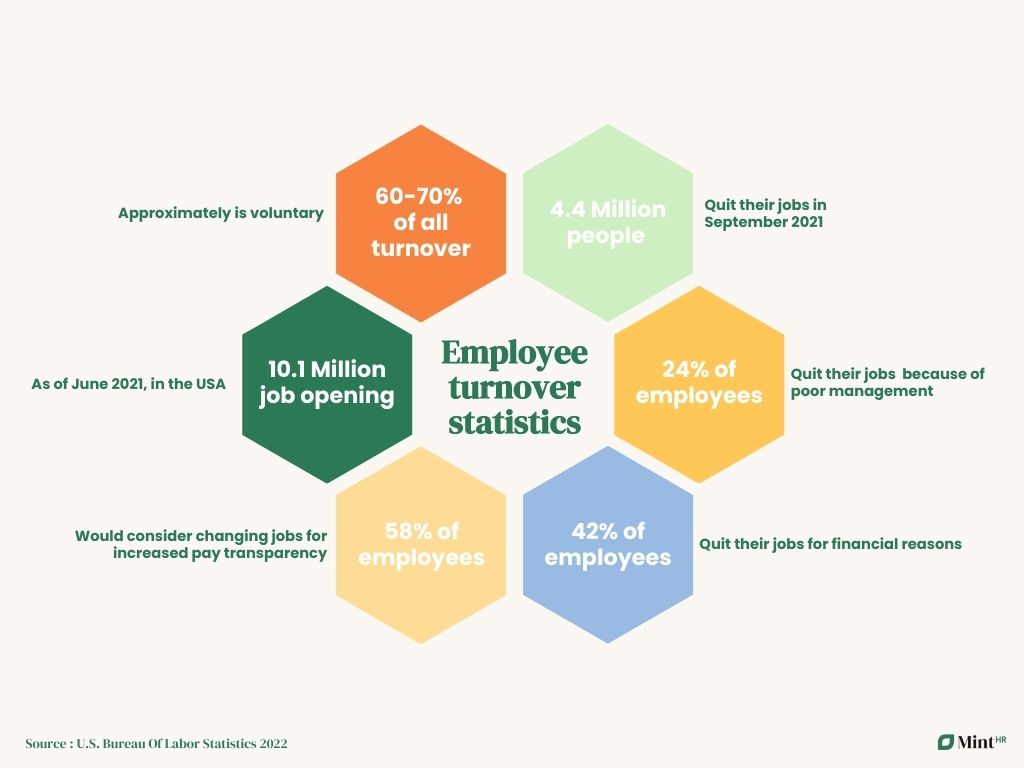Employee turnover : 11 ways to reduce it

High employee turnover costs businesses dearly. Estimated at around a third of an employee’s salary, the costs and disruption involved in covering a single employee’s workload and recruiting for a replacement quickly add up, becoming a cost that few organizations want to pay out for.
The cost of hiring a new employee, the costs of training them up to full performance levels, and of course, lost productivity of having someone new to train can be significant.
For some employees, it will also mean the loss of benefits such as health insurance - something that is removed from their salary when they leave. The impact on morale within an organization
Of course, if an organization loses a lower-paid employee, the cost impact will be lower than losing a top-performing executive. However, if lower-paid employees are leaving on a regular basis, that cost can quickly add up and become a drain on an organization’s resources.
More than a cost impact, high staff turnover can damage culture, reduce product quality and affect customer satisfaction. It is clear that it needs to be addressed for the ongoing health of any enterprise.
[Sommaire]
Why is it important to measure employee turnover ?
Organizations need to know the staff turnover rate to benchmark against industry norms and spot any potential issues brewing.
When an organization experiences high employee turnover, it can be a sign that something is wrong. It might be that the company is not doing enough to retain its employees or that there are factors within the organization that are causing employees to leave.
How can you analyze your organization’s turnover rate ?
You can analyze why your talents leave your organization using a number of methods. The most common way to calculate employee turnover is to divide the number of employees who have left in a given period by the average number of employees during that period. This will give you a percentage figure that you can use to compare different time periods or different departments within your organization.
You can also use staff turnover data to calculate the cost of the annual turnover rate. This is the cost to your organization of replacing an employee who leaves. The cost can be high, particularly in senior or specialist roles. It is essential to consider it when deciding how to reduce the rate.
What is a high employee turnover ?
There is no definitive answer to this question as it will vary from organization to organization and industry to industry. However, a good rule of thumb is that any staff turnover rate above 20% should be cause for concern.
Once you know your turnover rate, you can start putting measures to reduce it. But before understanding what counts as high turnover, it is important to know how to calculate an organization’s turnover rate.
How to calculate employee turnover :
Employee turnover rate = (number of employees who left the company during a period / average number of employees during that period) x 100.
To establish your employee turnover figure, divide the number of employees who leave within a set period of time by the average number of employees who work in the same time frame. You then multiply that number by 100 to create a percentage.
For instance, if you have 300 employees working for you for over a year and 15 employees leave during that period, your turnover rate would be 5%.
Now, it is time to examine that figure. Turnover rates vary enormously depending on your industry. Industries with lower turnover rates include education and accountancy, while those with higher turnover rates include media, construction, and catering. Instead of comparing your turnover rate with a national rate that covers all industries, it is more helpful to review it against your industry average.

What is the difference between healthy turnover and unhealthy employee turnover ?
Not all turnover is equal. A degree of employee turnover is necessary to ensure a flow of talent into a business bringing fresh ideas and new energy. Factors such as retirement, employees moving to new neighborhoods, or employees changing careers will always happen. This could be described as a healthy turnover.
In contrast, unhealthy turnover damages an organization. This could be due to :
- Highly skilled employees leave for other organizations because they are not getting the career progression they want.
- Turnover that focuses on one department or skill. Imagine if nearly all of your admin staff handed in their notice !
- New employees fail to fit into an organization and quickly leave after starting.
- Unclear job descriptions : The prevalence of social media has given employees unprecedented transparency into what their peers are doing and the types of roles they are performing. If an organization can not clearly articulate what a role entails, it will have difficulty attracting and retaining suitable candidates.
- Lack of development opportunities : Employees who feel they have no chance to develop or progress are more likely to start looking for a new role where they feel their skills will be better utilized.
- Low pay : This is an obvious one, an employee who feels underpaid is much more likely to look for a new job as soon as an opportunity arises.
- Poor management : Employees who do not feel supported or valued by their managers are more likely to start job hunting.
- A toxic work environment: An organization with a poor culture, where employees do not feel valued or respected, is an organization that will have a high turnover rate.
When an employee leaves your organization, their departure provides you with an opportunity to learn more about the reasons they are leaving. This information can be invaluable in helping you to identify patterns and potential problems within your business.
It is important to recognize that low turnover can be unhealthy. Perhaps a company does not challenge individuals to work hard but offers good benefits such as high pay and a good pension. In this situation, turnover may be low because employees are so comfortable. This can create teams who underperform and fall victim to groupthink.
If you have a high staff turnover rate, it is important to take action to address the root causes. Doing so will improve your organization’s productivity and profitability.
What is the difference between voluntary and involuntary employee turnover ?
Although turnover is often voluntary, this is not always the case. Employees who leave of their own accord are leaving voluntarily. Voluntary turnover can be disruptive to a business because leaders and managers have not been able to choose who goes and when. This disruption can affect team productivity due to the effect on the rest of the team and is costly to manage.
In contrast, involuntary turnover is initiated by the organization. This might be through a process of restructuring, redundancy, or dismissal. Involuntary turnover is often less disruptive to a business as the decision has been made by the organization.
This may be because of financial reasons such as redundancies, or it may be because of an employee-specific issue such as underperformance or misconduct. Even though involuntary turnover gives leaders more control over who leaves the team, it must be carefully managed to avoid the risk of legal action resulting from wrongful dismissal.
If managed well, involuntary turnover can be positive for an organization because of the way it either reduces costs or removes undesirable employees ready to be replaced with more appropriate members of staff.
General employee turnover statistics
(source : U.S. Bureau Of Labor Statistics)
4.4 million people quit their jobs in September 2021 :
That is the highest number of quitters since the Bureau of Labor Statistics began tracking this data in 2000.
Approximately 60-70% of all turnover is voluntary :
This includes employees who leave to take up a new role, those who retire, and those who are leaving the workforce.
The cost of employee turnover varies from 10-30% of an employee’s annual salary for entry-level positions up to 213% of an employee’s annual salary for senior executives :
This is based on the calculation that it costs $7,000 to replace an employee earning $30,000 per year. The employee turnover rates are highest in the first year of employment.
This is known as ‘churn’ and is most common in industries with a high proportion of minimum wage or entry-level positions.
As of June 2021, there are 10.1 million job openings in the United States :
The staff turnover rate is currently 3.5%. This is down from 3.7% in May 2021 and is the lowest since December 2000.
17.42% of employees who quit their job will do it within their first month of employment :
This is known as ‘switching costs’ and is a key reason why employee retention is important. The cost of employee turnover can be high, especially in the first year after someone starts a new job.
58% of employees would consider changing jobs for increased pay transparency :
This suggests that a lack of pay transparency is one of the key reasons why employees leave their jobs.
42% of employees who quit their jobs do so for financial reasons :
The most common reason that people leave their jobs is money. This includes a desire for increased pay, bonuses, and benefits.
24% of employees who quit their jobs do so because of poor management :
The second most common reason that people leave their jobs is poor management. This includes a lack of leadership, direction, and support from managers.
As of 2021, 92% of Human Resources leaders state that their top priority is employee experience :
Employee experience is the sum of all employee interactions with an organization. This includes everything from recruitment to onboarding, training, and development.

11 ways to cut employee turnover
Concerned that your employee turnover figure is too high ? Many of the factors associated with it are related to factors within your broader business.
Here are eleven things you could do to improve the health of your employee turnover rate :
1. Hire carefully :
Start as you mean to go on by being more selective about who you hire. By bringing employees on board who suit your company culture and have the necessary skills to do their jobs properly, you are more likely to build stronger talent retention.
Concerned your hiring techniques are a factor in high turnover ? Then focus on creating a more thorough recruitment process and ensure you take the time to fully understand how candidates will fit into a team and complement your business before providing a job offer.
2. Onboard new hires effectively :
It is not enough to just hire the right people – you need to ensure they feel supported in their new roles from day one. A study by Glassdoor found that a lack of onboarding is the number one reason new hires leave their jobs within the first year.
Ensure your onboarding process covers everything a new employee needs to know about your business, their role, and how they will be able to perform it effectively.
This means having a robust onboarding process in place which covers everything from the basics of their job through to your company culture and values.
3. Offer flexibility and prioritize wellness :
By giving employees greater flexibility and prioritizing wellness, you give employees more of a chance to bring their best selves to work. In doing so, you will create a more positive work environment, and employee retention will naturally follow.
This means they can be more productive, help enhance your organizational culture and stay healthier, avoiding problems such as burnout. For example, Indeed, one survey found that 80% of employees would be more loyal to their employers if they had flexible work options.
4. Involve employees in decisions :
Creating a more collaborative working environment is better for business, whichever way you look at it. Not only will you benefit from the diversity of experience in your decision-making, but the process of involving employees acts as on-the-job training for less experienced members of staff.
It also helps build trust and transparency, which are essential for employee retention. When decisions are made without employee input, it can lead to feelings of powerlessness and a lack of trust in management.
Furthermore, it is more motivating for employees as they can see that their views matter. As Steve Jobs said, ‘It does not make sense to hire smart people and tell them what to do : we hire smart people so they can tell us what to do.’
5. Recognize and celebrate success :
If your business is succeeding, that is a direct result of your employee’s efforts. So share that hard-earned success and celebrate as a team. Organizations that simply tick off successes without recognizing the hard work behind them create an unhealthy culture.
Reward and recognition can go a long way in driving employee engagement, a crucial factor in retention. There are several ways to incorporate reward and recognition into your organization. Informal feedback on good work is always appreciated by employees and costs nothing.
By sharing your wins and thanking your employees for their part, you create a closer bond, which in turn can improve employee engagement and turnover.
More formal rewards and recognition can be incorporated into your performance review process with bonuses and pay increases linked to strong performance. There are other more creative ways to reward employees, such as with tickets to an event or a day off to relax with family and friends.
6. Nurture a strong organizational culture :
Organizations with a strong and positive culture tend to see a lower employee turnover rate. So it makes sense to invest in your company culture. As well as nurturing your culture from the inside, it is important to focus your recruitment efforts on employees who share your cultural norms and values.
The first step is to establish what your organization’s values are. These should be values that everyone in the company can get behind and which guide employee behavior.
Once you have established your values, make sure they are communicated to all employees and that they form part of the employee onboarding process. You can also reinforce these values by sharing stories of employee behavior that exemplify them.
If you recruit employees who are not aligned with your values, they will be unlikely to fit in and either leave or upset your team and cause other valued team members to leave.
7. Set clear expectations :
Poor communication can become confusing and demotivating for your employees. By setting clear and reasonable expectations throughout your company, you can create better employee engagement, which in turn helps reduce turnover.
Ensuring you communicate your organizational vision and purpose is essential, but you should also be sure that employees understand how the vision applies to them. Setting individual objectives and having regular reviews helps keep these expectations top of mind for employees and shows them that their work is relevant to the success of the organization.
8. Foster camaraderie :
As counterintuitive as it seems, by encouraging or allowing employees to socialize and build meaningful friendships at work, you will see improved engagement. And, of course, improved engagement correlates with improved retention.
The facts speak for themselves,Gallup found that women who say they have a best friend at work are more than twice as likely to be engaged (63%) compared with the women who say otherwise (29%).
9. Train your managers :
It is often said that employees do not leave companies; they leave managers. Provide managers with coaching and training to improve their leadership skills; managers are usually placed in their roles because of technical expertise despite having no management experience. As a result, they may lack the emotional intelligence required to manage people effectively.
When employee turnover is high, it can be tempting to blame your employees. However, more often than not, the managers are at fault. Managers play a crucial role in employee retention; they are the ones who set the tone for employee engagement and motivation.
By developing strong managers in your organization, you can be confident that you will start to reduce negative turnover.
10. Invest in soft skills :
Success is not just about technical ability; soft skills are also essential. Skills such as empathy, communication, and self-awareness can help improve relationships within the business and improve organizational success.
By recruiting employees with a full range of skills and providing training and coaching to help develop these skills, you will have a more effective workforce.
11. Create a comprehensive onboarding program :
Onboarding is recognized as essential for talent retention. Not only will an onboarding program help reduce new starter turnover, but it can also speed up the amount of time it will take for new employees to become fully productive. This is more cost-effective for your organization and more engaging for your employees.
Employee turnover rates are nearly always an indicator of other factors within an organization. Happy, motivated employees will always be more likely to remain with their employer. In contrast, employees who feel underappreciated and demotivated will either leave or worse; they will stay and affect productivity and morale.
Give your employees the support and tools they need to thrive, and you will soon see your retention figures improve.

Employee Turnover FAQ
Who is responsible for employee turnover?
There is no one person responsible for employee turnover. Instead, it is usually the result of a combination of factors. However, managers play an important role in employee retention and should focus on creating a positive work environment and fostering employee engagement.
What is the average employee turnover rate?
The average employee turnover rate is around 16%. However, this varies depending on the industry and company size. For example, the turnover rate in the hospitality industry is around 70%.
How long does it take for an employee to be fully productive?
It usually takes around two to three months for an employee to be fully productive. However, this can vary depending on the level of experience and training required for the role.
Why should I care about employee retention?
Employee retention is necessary because it costs money to replace employees. The cost of replacing an employee can be up to 150% of their salary. In addition, high turnover rates can negatively impact morale and productivity in the workplace.
Conclusion
Staff turnover is a huge issue for businesses of all sizes. Not only does it cost money to replace employees, but it can also negatively impact morale and productivity in the workplace.
There are many factors that contribute to it, but there are also many things that managers can do to improve their retention rates. However, Companies can reduce turnover and improve organizational success by creating a positive work environment, fostering employee engagement, and investing in employee development.
Discover similar articles
Refresh
your HR & IT processes
Ready to streamline your HR & IT processes?



